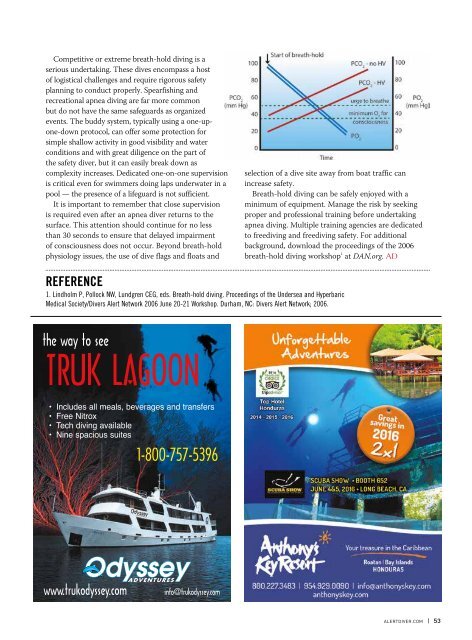AD 2016 Q2
As we pointed out in the spring 2013 edition of the Alert Diver, even being a dive buddy has potential legal implications. So, to bump this up a notch, what about the diver training organisations themselves? Where do they stand? How do they relate to South African law? Are they all considered the same under our legal system in spite of the differences in organisational structures and training programmes? How does this affect their respective instructors and trainee divers from a legal perspective? These are not exactly simple questions. It is certainly true that the respective training organisations differ in a number of ways. However, this does not imply that there are necessarily differential legal implications for each of them. In fact, under South African law, the legal principles are common in all matters. Therefore, if you suffer a loss and you (or your estate in the case of a fatality) wish to recover damages, the legal principles would be applied commonly; whether you are driving or diving. Although not a frequent occurrence, there have been quite a number of law suits associated with diving injuries and damages in South Africa. This is not surprising, as the occurrence of law suits is really a function of “numbers”. As training increases, so do the chances of injuries and, with it, the chances of legal recourse. So, it remains wise to insure yourself, your equipment or your business in a proper and effective way. But before getting back to the potential differences amongst the training agencies, let’s first explore the foundational legal principles on which any civil claim would be adjudicated: inherent risk, negligence and duty to take care.
As we pointed out in the spring 2013 edition of the Alert Diver, even being a dive buddy has potential legal implications. So, to bump this up a notch, what about the diver training organisations themselves? Where do they stand? How do they relate to South African law? Are they all considered the same under our legal system in spite of the differences in organisational structures and training programmes? How does this affect their respective instructors and trainee divers from a legal perspective? These are not exactly simple questions.
It is certainly true that the respective training organisations differ in a number of ways. However, this does not imply that there are necessarily differential legal implications for each of them. In fact, under South African law, the legal principles are common in all matters. Therefore, if you suffer a loss and you (or your estate in the case of a fatality) wish to recover damages, the legal principles would be applied commonly; whether you are driving or diving.
Although not a frequent occurrence, there have been quite a number of law suits associated with diving injuries and damages in South Africa. This is not surprising, as the occurrence of law suits is really a function of “numbers”. As training increases, so do the chances of injuries and, with it, the chances of legal recourse.
So, it remains wise to insure yourself, your equipment or your business in a proper and effective way. But before getting back to the potential differences amongst the training agencies, let’s first explore the foundational legal principles on which any civil claim would be adjudicated: inherent risk, negligence and duty to take care.
Create successful ePaper yourself
Turn your PDF publications into a flip-book with our unique Google optimized e-Paper software.
Competitive or extreme breath-hold diving is a<br />
serious undertaking. These dives encompass a host<br />
of logistical challenges and require rigorous safety<br />
planning to conduct properly. Spearfishing and<br />
recreational apnea diving are far more common<br />
but do not have the same safeguards as organized<br />
events. The buddy system, typically using a one-upone-down<br />
protocol, can offer some protection for<br />
simple shallow activity in good visibility and water<br />
conditions and with great diligence on the part of<br />
the safety diver, but it can easily break down as<br />
complexity increases. Dedicated one-on-one supervision<br />
is critical even for swimmers doing laps underwater in a<br />
pool — the presence of a lifeguard is not sufficient.<br />
It is important to remember that close supervision<br />
is required even after an apnea diver returns to the<br />
surface. This attention should continue for no less<br />
than 30 seconds to ensure that delayed impairment<br />
of consciousness does not occur. Beyond breath-hold<br />
physiology issues, the use of dive flags and floats and<br />
selection of a dive site away from boat traffic can<br />
increase safety.<br />
Breath-hold diving can be safely enjoyed with a<br />
minimum of equipment. Manage the risk by seeking<br />
proper and professional training before undertaking<br />
apnea diving. Multiple training agencies are dedicated<br />
to freediving and freediving safety. For additional<br />
background, download the proceedings of the 2006<br />
breath-hold diving workshop 1 at DAN.org. <strong>AD</strong><br />
REFERENCE<br />
1. Lindholm P, Pollock NW, Lundgren CEG, eds. Breath-hold diving. Proceedings of the Undersea and Hyperbaric<br />
Medical Society/Divers Alert Network 2006 June 20-21 Workshop. Durham, NC: Divers Alert Network; 2006.<br />
• Includes all meals, beverages and transfers<br />
• Free Nitrox<br />
• Tech diving available<br />
• Nine spacious suites<br />
ALERTDIVER.COM | 53









